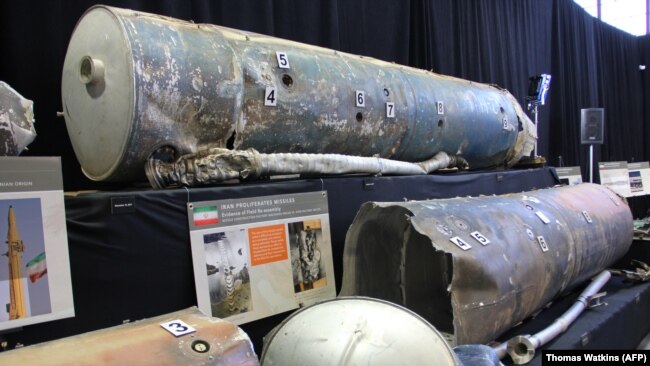Radiofarda – Pentagon and the U.S. State Department went all out on Thursday to show that Iran is breaking United Nations resolutions by aggressively sending arms to rebel groups in the region.
Iran Action Group chief Brian Hook said on Thursday November 29 that Iranian arms displayed by the Pentagon were “New evidence of Iran’s ongoing missile proliferation,” and stressed “The Iranian threat is growing and we are accumulating risks of escalation in the region if we fail to act.”
The collection of weapons on display included pieces of what the Pentagon said were Iranian weapons transferred to militants in Yemen and Afghanistan.
This was the second presentation of Iranian weapons by the Pentagon. Hook’s statement coincided with growing concern in Congress over U.S. military support for the Saudi-led coalition in Yemen’s civil war, which has led to a deep humanitarian crisis, Reuters news agency observed on Thursday.
Meanwhile, US Secretary of State Mike Pompeo had said Wednesday evening that “reducing ties with Saudi Arabia will encourage Iran.” He made the comment after a closed session of the United States Senate that debated a response to Saudi Arabia for the murder of columnist Jamal Khashoggi in the Saudi consulate in Istanbul.
The senators passed a resolution to pull U.S. support from the war in Yemen, in what is seen as a rebuke to both Riyadh and President Donald Trump.
Later on Thursday, Trump told reporters that he will not meet Saudi Crown Prince Mohammad Bin Salman during his visit to Argentina where he is slated to take part in G-20 summit.
In his speech, Brian Hook maintained that “Iran’s support of the Houthi militants has deepened. Its backing of terrorists across the world has increased, and its efforts to undermine regional stability have expanded.”
He also pointed out “Iran’s relentless commitment to put more weapons into the hands of even more of its proxies regardless of the sufferings.”
Hook added: “Iran has been prohibited by several UN resolutions for exporting arms for a decade,” adding that “This display reveals an outlaw regime exporting arms as it pleases.”
He emphasized that what was on display included a “surface to air missile designed and manufactured in Iran with the writing in Farsi on its side saying that Iranians don’t mind being caught violating UN resolutions. These are missiles intercepted by Saudi Arabia in Yemen earlier this year. The Iranians wanted to deliver these to the Houthis to target coalition aircrafts.”

Iran Says U.S. Bases And Aircraft Carriers Within Missile Range
Hook stressed that “These missiles pose a clear and present danger to civil aviation in the region.”
He added that the display also included “anti-tank guided missiles manufactured in Iran, seized in an arms cache aboard a vessel in the Arabian Sea.”
Shipping arms to Yemen, Afghanistan and other countries by Iran would be in violation of United Nations resolutions.
Reuters was reportedly given advanced access to the military hangar at Joint Base Anacostia-Bolling just outside of Washington where the U.S. Defense Department put the fragments of weaponry on display and explained how it concluded that they came from Iran.
“We want there to be no doubt across the world that this is a priority for the United States and that it’s in international interest to address it,” Reuters quoted Katie Wheelbarger, the principal US deputy assistant secretary of defense for international security affairs.
According to Reuters, the Pentagon explained in detail why it believed the arms on display came from Iran, noting what it said were Iranian corporate logos on arms fragments and the unique nature of the designs of Iranian weaponry including Sayad-2 surface to air (SAM) missiles.
Meanwhile, in line with the United States’ accusation about Iran’s link to the Taliban in Afghanistan, the Pentagon displayed a number of Fajr rockets, that it said Iran had provided to the militant group. It said the rockets were Iranian because of the unique markings on the rockets and the paint scheme, along with the markings on them.
Except in the case of the Taliban, the Islamic Republic has not shied away from openly supporting various militant groups, including Palestinian factions bent on carrying on conflict with Israel or Houthi rebels in Yemen.
 Shabtabnews In this dark night, I have lost my way – Arise from a corner, oh you the star of guidance.
Shabtabnews In this dark night, I have lost my way – Arise from a corner, oh you the star of guidance.



